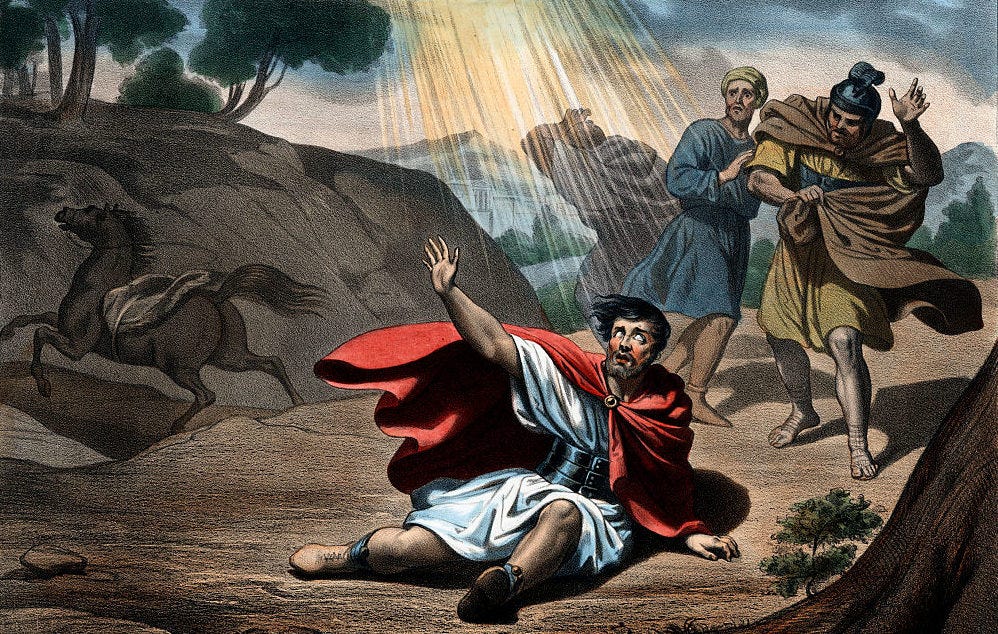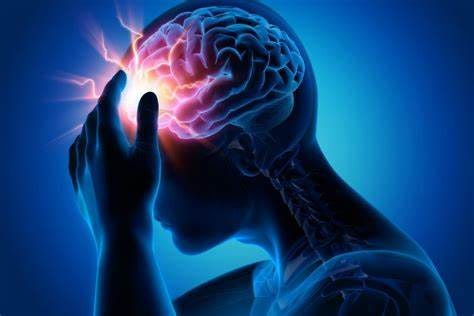Muhammad: The Epileptic Prophet of Islam
Did the Prophet Muhammad Suffer From Temporal Lobe Epilepsy?
INTRODUCTION
If there is but a single religious figure from human history that people should be discouraged from emulating, it is the founder of the Islamic religion, Muhammad. Should you possess the stomach to read through the compendium of medieval torture pornography that is the Qur’an and the Islamic hadiths, you’ll see what I’m talking about. Muhammad, according to his own religion’s sacred scripture, was a murderous paedophile and a child-wife-beater. This is a somewhat oversimplified description of a character who also possessed charitable, loving, gentle and benevolent qualities as well, but I shall leave the starry-eyed doting over Muhammad to both Muslims and irrationally romanticising scholars like Karen Armstrong, and just focus on his contemptible and capricious conduct. But we must ask, what was it about Muhammad that made him so extremely kind on the one hand, yet so insanely violent, licentious and brutal on the other? Was he simply a product of his environment, or was there something actually wrong with his brain, a defect that could have collaborated with his violent environment to make him extremely erratic, violent, perverted and generally psychotic?
Now, before I launch into an investigation into whether or not he may have suffered temporal lobe epilepsy, I need to offer this caveat. This essay in no way means to smear or demean people who suffer temporal lobe epilepsy, as it is a condition that causes people great suffering and challenges. Nor do I intend to generalize the individual experiences and symptoms experienced by those who suffer this neurological condition. I am simply focusing this brief investigation on the founder of Islam as other scholars and historians have done with other religious figures from history. I will draw upon the findings of experts in the relevant fields to compare some of the common symptoms of temporal lobe epilepsy to some of the biographical reports concerning Muhammad. In their investigation into whether or not Joan or Arc may have suffered temporal lobe epilepsy, Nicastro and Picard write:
From the age of thirteen, Joan of Arc experienced frequent episodes of auditory hallucinations associated with elementary or complex visual hallucinations (e.g., a great light or human faces). These had sudden onset, lasting seconds or minutes at most, and occurred when awake or during sleep, arousing her. Some could be triggered by an auditory stimulus. She had no disorganized thought between the episodes. [1]
Nicastro and Picard conclude:
The semiology of the episodes is very suggestive of epileptic seizures, which have been considered as ecstatic by some authors or as partial epilepsy with auditory features by others, which seems more concordant with the ictal symptoms. The auditory and visual hallucinations could have had a religious content because during her childhood and adolescence, she was brought up in a religious environment, insomuch as this content first undefined only appeared after a few seizures. We can suppose that such hallucinations, without the knowledge of their medical origin, gave her a sense of divine mission, hence, a real strength to try to accomplish the orders she heard during the episodes. Her role during the Hundred Years' War and her narration of her strange episodes led her to be burned for heresy at the age of nineteen, yet rehabilitated 25 years later and to be canonized for her achievements in 1920. [2]
d’Orsi and Tinuper also investigated the possibility that Joan of Arc could have suffered temporal lobe epilepsy, and they even speculate that this neurological condition could also explain the voices that used to visit Socrates, famously known as ‘Socrates Daemons’. [3]
Landsborough, writing in the Journal of Neurology, Neurosurgery, and Psychiatry, investigates St Paul’s visions and episode on the Road to Damascus as recorded in the New Testament (See: 2 Corinthians 12 & Acts 16:6-10). Landsborough observed:
St Paul (Paul of Tarsus), in a letter to the Church in Corinth, describes an ecstatic personal experience in which he felt "caught up to paradise", and mentions other "visions". In relation to these he writes of a "thorn in the flesh", a metaphor for an unpleasant infirmity which periodically racked him. It is postulated that Paul was subject to episodes of temporal lobe epilepsy (TLE) or complex partial seizures, some of which progressed to generalised convulsions. Much has been written about the nature of Paul's illness,I-10 and many theories propounded. The evidence upon which a diagnosis can be made is meagre, yet the description of his ecstatic experience is perhaps the most important index. [4]
THE HADITH: THE SECONDARY SOURCE OF AUTHORITY IN ISLAM
As I will be drawing from the hadith, I should first provide the reader with a little context. The Islamic hadith are regarded as the secondary source of textual authority in Islam, and they purport to record the sayings and doings of Muhammad and his contemporaries. The hadiths are graded on a scale from least reliable to most reliable (‘Sahih’). I will only be relying on the Sahih (reliable) hadiths. I should also qualify the employment of these texts, for in reality they are very unreliable, due to the fact that the earliest of these hadith were compiled and codified, if not created in large part in the ninth century, well after the time of the events and sayings they allege to record [5] But not only do these texts fail the historical test of contemporaneity, they are also afflicted with severe religious bias, infused with myth and tainted by various other historical inaccuracies and contradictions. Having said all of this, these texts are regarded as the secondary source of authority to a worldwide faith, so who am I to question their integrity? In case it isn’t already obvious to the reader, any investigation into the possibility that a historical character had temporal lobe epilepsy is purely speculative, as we would need their biological remains to arrive at more solid conclusions. Nonetheless, there is value in speculating along the lines of established scholarship in the relevant fields.
THE PEDOPHILE PROPHET
According to the Sahih Bukhari:
…the Prophet married her (Aisha) when she was six years old and he consummated his marriage when she was nine years old… [6]
Muhammad’s paedophilia is further reiterated in the Sahih Muslim, which says:
A’isha reported: “Allah’s Apostle married me when I was six years old, and I was admitted to his house when I was nine years old. [7]
Just to give you an idea of how psychologically immature Aisha was when she was overcome by this perverted predator, the Sahih Muslim reports that when she entered his house she brought her dolls with her. [8] But the perversion doesn’t stop there, for Muhammad’s child-bride was also like his niece, the daughter of his “brother” Abu Bakr. Mr Bakr wasn’t initially keen to push his prepubescent daughter into his middle-aged brother’s bed, but with some Joseph Smith-styled manipulation, Muhammad managed to acquire his young and innocent target. [9] I can almost hear the Islamists and Western liberal defenders of Islam screaming: “But paedophilia was all the rage back then!” Yes, calm down, I will get to that, but before I do, let’s hear what modern psychology and neuroscience have to say about paedophilia.
Many psychologists believe that paedophilia can be the result of early childhood trauma, with numerous paedophiles reporting that they themselves had been abused as children. [10] In addition to common psychological causes highlighted by numerous studies, neuroscience has shed some very interesting light upon some of the neurological factors associated with paedophilia, light that may well illuminate the very heart of Muhammad’s paedophilia.
There is a large body of evidence linking paedophilia with abnormalities in the brain, [11] and numerous neuroscientists have noted that there is a notable correlation between temporal lobe epilepsy and paedophilia. [12] Yes, here is where I am going to suggest that Muhammad may have in fact suffered from temporal lobe epilepsy, but no, I am not suggesting that paedophilia is a blanket symptom common to all cases of TLE, yet it has been observed by experts to be one potentially correlated symptom. Let’s take a look at some of the common symptoms of TLE and compare them to the biographical accounts concerning Muhammad.
MUHAMMAD AND TEMPORAL LOBE EPILEPSY
VISUAL HALLUCINATIONS [13]
Muhammad was reported to have seen and spoken with Gabriel, the mythical angel from the Bible. [14] At first Muhammad thought he was being possessed by a devil, which is rather humorous given the Jewish and Christian traditions surrounding this particular angel, but needless to say, Muhammad is reported to have experienced this symptom of TLE.
AUDITORY HALLUCINATIONS [15]
In Ladio, Moien-Afshari and Tellez-Zenteno’s ‘A Comprehensive Review of Temporal Lobe Epilepsy,’ they say:
Auditory auras usually manifest as auditory hallucination such as sounds, which are generated by activation of the Heschl’s gyrus. Complex auditory hallucinations, such as hearing voices or tunes, can also occur. They are attributed to activation of the temporal association cortex (Loddenkemper & Kotagal, 2005). [16]
When we read of Muhammad allegedly receiving the Qur’an from Allah we discover that Muhammad suffered severe auditory hallucinations. The Sahih Bukhari reports:
Allah’s Apostle replied, “Sometimes it is (revealed) like the ringing of a bell, this form of Inspiration is the hardest of all and then this state passes ‘ off after I have grasped what is inspired. [17]
INTENSE FEAR [18]
Intense fear is one of the common emotional symptoms of temporal lobe seizures. Once again, from the Sahih Bukhari we read:
Then Allah’s Apostle returned with the Inspiration and with his heart beating severely. Then he went to Khadija bint Khuwailid and said, “Cover me! Cover me!” They covered him till his fear was over and after that he told her everything that had happened and said, “I fear that something may happen to me.” [19]
ELEVATED HEART RATE [20]
Temporal lobe seizures frequently result in an elevated heart rate, which can cause sweating and heavy breathing. [21] Regarding this symptom the Bukhari relays the words of Muhammad’s child-bride Aisha:
Verily I saw the Prophet being inspired Divinely on a very cold day and noticed the Sweat dropping from his forehead (as the Inspiration was over). [22] Once again, in the alleged words of Aisha: The Prophet returned to Khadija while his heart was beating rapidly. She took him to Waraqa bin Naufal who was a Christian convert and used to read the Gospels in Arabic Waraqa asked (the Prophet), “What do you see?” When he told him, Waraqa said, “That is the same angel whom Allah sent to the Prophet) Moses. Should I live till you receive the Divine Message, I will support you strongly.” [23]
LIP SMACKING [24]
Lip smacking refers to the vigorous smacking and moving of the lips, and it is a common automatism associated with temporal lobe epilepsy. In the Bukhari it is reported that:
“Allah’s Apostle used to bear the revelation with great trouble and used to move his lips (quickly) with the Inspiration.” [25]
HYPERSEXUALITY [26]
The last symptom of temporal lobe epilepsy I wish to discuss is hypersexuality. In an article published by the Psychology Department at the University of British Colombia entitled ‘Pedophilia and Brain Function,’ Kaitlyn Goldsmith says:
…pedophilia may be related to abnormalities within structures in the temporal lobe, which has been associated with hypersexuality. Hypersexuality is the tendency to seek out sexual activity with both appropriate and inappropriate partners or objects at appropriate or inappropriate times. [27]
On this issue we note that Muhammad wasn’t only having inappropriate sexual relations with a child, but he was also having sex with women closer to his age, and much older. [28] According to the Bukhari, Muhammad was married to either nine or eleven women at the same time and if that isn’t shocking enough, it’s also recorded that he would have sex with each and every one of them in marathon twenty-four hour stints. [29] But his hypersexuality didn’t stop there, for it is also reported that he raped a seventeen-year-old Jewish girl on the same night that his men had killed her husband and her family. [30] The Bukhari also says that he had the sexual strength (appetite) of 30 men. [31] Further, from this same (“reliable”) source of Islamic texts we read:
Narrated Sulaiman bin Yasar: I asked ‘Aisha about the clothes soiled with semen. She replied, “I used to wash it off the clothes of Allah’s Apostle and he would go for the prayer while water spots were still visible.” [32] And; Narrated ‘Amr bin Maimun: I heard Sulaiman bin Yasar talking about the clothes soiled with semen. He said that ‘Aisha had said, “I used to wash it off the clothes of Allah’s Apostle and he would go for the prayers while water spots were still visible on them. [33]
Further still, Narrated ‘Aisha: I used to wash the semen off the clothes of the Prophet and even then I used to notice one or more spots on them. [34] Due to the constraints of time and space, I am unable to list the entire scope of Muhammad’s perverted and depraved exploits, however, I think it is safe to conclude that he was suffering from this symptom correlated with TLE. I should, as an aside, point out that not all people suffering TLE experience hypersexuality and I again in no way wish to imply that all male sufferers of TLE are necessarily paedophiles and sexual deviants, but the evidence does point to a correlation between TLE and paedophilia, and in environments where paedophilia isn’t taboo, this can potentially act as a ‘disinhibiter’ for paedophilic behaviour, as seems to have been the case in Muhammad’s time, but I will return to this issue in a moment. To conclude our diagnosis of Muhammad, I will give Dr Patrick McNamara the final word on the issue of religious delusions and temporal lobe epilepsy. In his brilliant book, ‘The Neuroscience of Religious Experience’ he says:
There have now been dozens of studies that convincingly demonstrate a link between some forms of TLE and heightened religiosity in some TLE patients. During preictal and ictal states, when seizure activity is building up or commences, the religious symptomology may escalate into delusional states during which the patient claims that he or she is God or has seen God face to face…These patients may be riddled with anxiety and may spend hundreds of hours each week attempting to say a single prayer “correctly.” Or take the case of so-called “demonic possession” states. These patients may become utterly convinced that they are controlled by an evil and alien agent that means them harm. Some patients may be so tortured by the possession experience that the state can be life threatening. [35]
Now that we have established that Muhammad may have suffered from a neurological disorder, let’s return to the aforementioned screams of Muslim apologists and Western liberal defenders of this medieval paedophile. It is true that in this region, during this period in history, the notion of paedophilia didn’t exist, and that it was somewhat common to bed innocent and even reluctant children, for we may even find in the Qur’an a prescription for a three month waiting period for the divorcing of premenstrual girls. [36] However, in contradiction to the propaganda spewed into the ears of Muslims and Western liberal defenders of Islam, this was not the case prior to the brutal rise of Islam in countries ruled by the former religion of Zoroastrianism.
According to the marriage customs of the ancient Zoroastrians, a girl was forbidden to be married prior to the age of fifteen, which is still young by our standards, but certainly not by Muhammad’s. [37]
The biggest problem with the vacuous apology offered by apologists regarding Muhammad’s paedophilia is that although it may have been acceptable in darker and more ignorant times, it certainly isn’t now – yet the Qur’an and the hadiths, the two primary textual sources of authority in Islam, allow and even encourage this despicable and harmful practice. Once again, I must stress that I am neither suggesting nor implying that all, nor even most, Muslims follow the Qur’an and hadiths strictly, just as Jews and Christians don’t follow their horrendous scriptures to the letter; yet many do, and they’re crimes against children are justified by the codified core doctrines of their religion. So, if this perverted practice preserved within what is believed to be the infallible word of an all-knowing deity cannot be edited, repealed, nor even challenged, lest charges of blasphemy, racism, or bigotry ensue, where does this leave the poor young girls who are exploited by followers of this “Prophet?”
Are the cases of Islamic paedophilia too few to worry about, too infrequent to make mention of, let alone present us with justification to challenge the appropriateness of such vile and inappropriate teachings? I think not. If one is to examine the heartbreaking cases of child marriage in Islamic states such as Saudi Arabia, a country that has only recently raised the legal age of marriage to eighteen, much to the dismay of eighty-year-old men who enjoy marrying twelve-year-old girls, [38] or in Pakistan, Afghanistan, Iran, or even Egypt, for example – one will see that these archaic teachings found in these two primary Islamic corpuses texts are being correctly interpreted and enthusiastically applied. And here we arrive at the central problem. There are a plethora of verses within the central pillar of Islam (the Qur’an) that encourage Muslims to follow the example set by Muhammad, as well as ordering them to obey his commands. [39] For example, the Qur’an (33:21) says:
There has certainly been for you in the Messenger of Allah an excellent pattern for anyone whose hope is in Allah and the Last Day and [who] remembers Allah often.
But what kind of example did this human being set for his future followers? As well as being a paedophile with a penchant for beheading and murdering those who insulted him, [40] he was also reported to have been a wife-beater. [41]
CONCLUSION
So what are we to make of Muhammad’s abhorrent and irrational behaviour? Was he the product of faulty wiring, a bad environment, or possibly a combination of both - or was he just a mean and perverted old man? More importantly, what are we to make of verses in the Qur’an and hadith that encourage modern and even moderate Muslims to emulate his perverse behaviour, to walk like an epileptic wife-beating paedophile, if you will? Surely these exhortations serve no healthy function in societies marked by a superior moral code, a code that frowns upon and even proscribes rape, paedophilia, misogyny and beheadings for blasphemy, along with the various other machinations of medieval madness that marred Muhammad’s hostile and inhospitable environment.
Notwithstanding the pertinent nature of these questions, there is but one fundamental question raised by this investigation, and it cuts to the very heart of the religion of Islam: If Muhammad was suffering temporal lobe epilepsy, which may have been the case, then aren’t the 1.6 billion Muslims living in the world today simply squandering their precious lives in service to the hallucinations of a medieval tyrant who suffered temporal lobe epilepsy?
FURTHER READING
A differential diagnosis of the inspirational spells of Muhammad the Prophet of Islam.
Did Prophet Mohammad (PBUH) have epilepsy? A neurological analysis
Muhammad and Temporal Lobe Epilepsy (TLE)
Did Prophet Mohammad (PBUH) have epilepsy? A neurological analysis
END NOTES
Nicolas Nicastro, Fabienne Picard, Joan of Arc: Sanctity, witchcraft or epilepsy?, Epilepsy & Behavior, Volume 57, Part B, 2016, Pages 247-250, ISSN 1525-5050, https://doi.org/10.1016/j.yebeh.2015.12.043. (https://www.sciencedirect.com/science/article/pii/S1525505015006988).
Ibid.
Giuseppe d’Orsi, Paolo Tinuper, “I heard voices…”: From semiology, a historical review, and a new hypothesis on the presumed epilepsy of Joan of Arc, Epilepsy & Behavior, Volume 9, Issue 1, 2006, Pages 152-157, ISSN 1525-5050, https://doi.org/10.1016/j.yebeh.2006.04.020.
(https://www.sciencedirect.com/science/article/pii/S1525505006001752).
Landsborough D St Paul and temporal lobe epilepsy. Journal of Neurology, Neurosurgery & Psychiatry 1987;50:659-664.
John L. Esposito. The Oxford Dictionary of Islam. Oxford University Press (2004). pp. 46-47, 273.
Sahih al-Bukhari 7:62:64.
Sahih al-Muslim 8:3310.
Sahih al-Muslim 8:3311.
Sahih al-Bukhari 7:62:18.
DiChristina, Mariette. Abnormal Attraction.Scientific American Mind, 20.3 (2009): 76-81.
Schiffer, Boris. Brain Response to Visual Sexual Stimuli in Homosexual Pedophiles. Journal of Psychiatry and Neuroscience 33.1 (2008): 23.
Devinsky J, Sacks O, & Devinsky O (2009). Kluver-Bucy syndrome, hypersexuality, and the law. Neurocase: case studies in neuropsychology, neuropsychiatry, and behavioural neurology, 1-6 PMID: 19927260.
Henry Smithson & Matthew C. Walker. ABC of Epilepsy. Wiley-Blackwell (2012). p. 4; M.J. Turlough Fitzgerald, Gregory Gruener & Estomih Mtui. Clinical Neuroanatomy and Neuroscience. Saunders Elsevier (2012). p. 359; Hermann Stefan, Elinor Ben-Menachem Patrick Chauvel & Renzo Guerrini.Case Studies in Epilepsy: Common and Uncommon Presentations. Cambridge University Press (2012). pp. 58-60, 143.
Sahih al-Bukhari 1:1:3.
Turlough Fitzgerald, Gregory Gruener & Estomih Mtui. Clinical Neuroanatomy and Neuroscience. Saunders Elsevier (2012). p. 359.
Lady D. Ladino, Farzad Moien-Afshari & Jose F. Tellez-Zenteno. A Comprehensive Review of Temporal Lobe Epilepsy. https://www.iconceptpress.com
Sahih al-Bukhari 1:1:2.
Hermann Stefan, Elinor Ben-Menachem Patrick Chauvel & Renzo Guerrini.Case Studies in Epilepsy: Common and Uncommon Presentations. Cambridge University Press (2012). pp. 53, 135 & 174.
Sahih al-Bukhari 1:1:3.
Lady D. Ladino, Farzad Moien-Afshari & Jose F. Tellez-Zenteno. A Comprehensive Review of Temporal Lobe Epilepsy. https://www.iconceptpress.com
Hermann Stefan, Elinor Ben-Menachem Patrick Chauvel & Renzo Guerrini.Case Studies in Epilepsy: Common and Uncommon Presentations. Cambridge University Press (2012).
Sahih al-Bukhari 1:1:2.
Sahih al-Bukhari 4:55:605.
Charles G. Gross. Brain, Vision, Memory: Tales in the History of Neuroscience.The MIT Press (1998). p. 210; Hermann Stefan, Elinor Ben-Menachem Patrick Chauvel & Renzo Guerrini. Case Studies in Epilepsy: Common and Uncommon Presentations. Cambridge University Press (2012). p. 185.
Sahih al-Bukhari 1:1:4.
Kaitlyn Goldsmith. Pedophilia and Brain Function.Department of Psychology, University of British Colombia. (2012). p. 3.
Ibid.
Richard C. Martin, Saïd Amir Arjomand, Marcia Hermansen, Abdulkader Tayob, Rochelle Davis & John O. Voll. Encyclopedia of Islam & the Muslim World. Thomson-Gale (2004). p. 478.
Sahih al-Bukhari 1:5:268.
Sahih al-Bukhari 1:8:367.
Sahih al-Bukhari 1:5:268.
Sahih al-Bukhari 1:4:231.
Sahih al-Bukhari 1:4:232.
Sahih al-Bukhari 1:4:233.
Patrick McNamara. The Neuroscience of Religious Experience. Cambridge University Press (2009). p. 4.
Qur’an 65:4.
Yasna, 9; Vandidad, Fargard 14, 9.
com/id/36717454/ns/world_news-mideast_n_africa/t/girl-divorces–year-old-husband/
Qur’an 3:32, 3:132, 4:13, 4:59, 4:64, 4:69, etc…
Ibn Ishaq, A. Guillaume (trans.) The Life of Muhammad.Oxford University Press (2002). pp. 461-464; Qur’an 33:26.
Sahih al-Muslim 4:2127.









